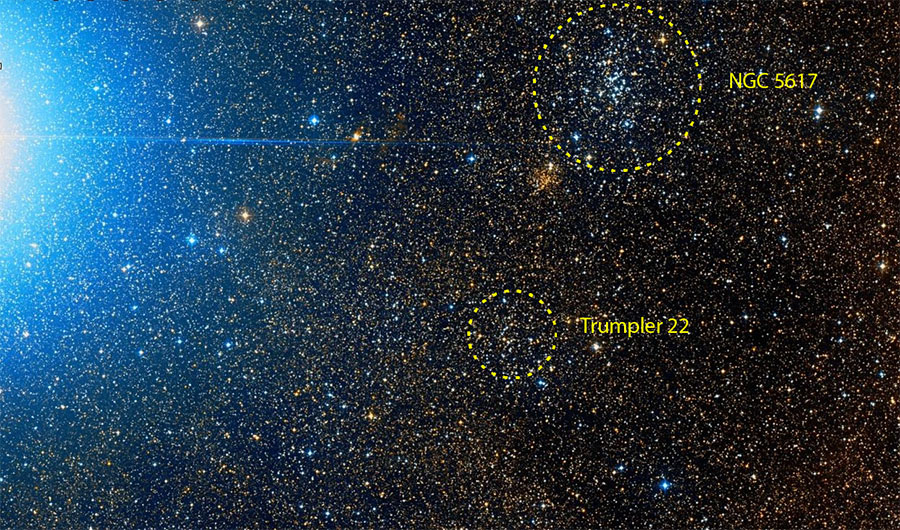IAU / Sky & Telescope (Roger Sinnott & Rick Fienberg)
This month, let’s take a look at a few of the many sights of Centaurus, the ninth-largest constellation by area (1,060 square degrees). Located deep in the south, Centaurus represents the centaur Chiron of classical Greek mythology, a creature with the body and legs of a horse and the upper half of a man. Centaurus is often portrayed on star maps as wielding a spear upon which a wolf is impaled. That wolf represents Lupus, one of constellations bordering Centaurus.
Dominating Centaurus are two triple-star systems that each look like single stars to the naked eye. They’re known as the “Two Pointers,“ or simply the Pointers, because if you draw a line from the first of them, Alpha Centauri, to the second, Beta, and continue on, you’ll find yourself pointing just a little to the north of Crux — an easy way to find the Cross. A couple of thousand years from now this Alpha-Beta line will point directly at Crux’s center, since Alpha’s proper motion is slowly changing its position on the sky.
The Alpha Centauri system is comprised of two bright, Sun-like stars — Rigil Kentaurus (Alpha Cen A) and Toliman (B) — plus a small, 11th-magnitude red dwarf star called Proxima Centauri, located a little over two degrees from the other two. Combined, Alpha Cen A and B have an apparent magnitude of –0.27, placing them third on the list of brightest naked-eye stars and star systems. The system is also the closest one to us, with Proxima being the nearest of the trio at just 4.2465 light-years.
Yellowish Alpha Cen is a smidgeon more massive than the Sun and 1.5 times as luminous (with an apparent magnitude of +0.01), while slightly orange Beta Cen is only half as luminous (mag. +1.35) and a smidgeon under one solar mass. Through a small telescope, the two stars are easily separated. And call me crazy, but I always get a sort of warm and fuzzy feeling when looking at this system, knowing that, excluding Proxima, our nearest stellar neighbours are so much like our Sun. Space is so vast and empty, it’s comforting to know we’re in close kindred company.
The Milky Way fills around half of Centaurus, so it’s no surprise that this busy part of the sky is loaded with star clusters. I’ve picked a handful near the Pointers for this month’s tour; we’ll get to others in future installments.

Fernando Menezes / S&T Online Photo Gallery
Starting at Alpha Cen, head in a straight line toward Beta Cen. About a third of the way along is the open cluster NGC 5617. Discovered by James Dunlop while observing from Parramatta (near Sydney) in 1826, he described it as “a cluster of small stars of mixed magnitudes, considerably congregated towards the centre,” while John Herschel called it “very rich.” With a combined magnitude of 6.3, the cluster has a strong central concentration and boasts about 10 stars of 10th or 11th magnitude (and dozens more a bit fainter). This cluster is suited to telescopes of 125 mm aperture or more under dark skies. There is a lovely scattering of red stars in the vicinity.

Background image: DSS2
Interestingly, around 1/2° almost due south is another cluster, Trumpler 22, which astronomers consider to be a gravitationally bound sibling of NGC 5617. Tr 22 is sparser than NGC 5617 and harder to make out against the background stars, but see if you can spot its central circlet of nine 10th- to -12th-magnitude stars.
A tad more than 1° north and only very slightly west of NGC 5617 is the magnitude-7.7 cluster NGC 5606. This cluster contains around four dozen stars; its condensed core features a group of four closely spaced, white stars in a line running northeast-southwest. Another stellar pair is at right angles to them just to their northeast.
Swing your gaze now to Beta Cen, and from there slew just under 2° south and a little bit west to find yourself at NGC 5316, which is just at the cusp of naked-eye visibility at magnitude 6. Astronomers think there are more than 500 stars in this cluster, but you won’t see that many. Through a 5-inch aperture, expect to make out a dozen or so stars in a sort of wedge shape; apertures of 20 to 40 cm will reveal dozens more.

Stellarium background with author additions
Continue along the same line you used to get from Beta Cen to NGC 5316, and go 1.3° further to land on NGC 5281. This magnitude 5.9 cluster has a tight center dominated by a lovely magnitude-8.4 orange star that heads a small arc of white stars, with another arc of slightly fainter, bluish-white stars bisecting them. An aperture of 114 mm will reveal this nicely.
Incidentally, if you use a Go To telescope and enter this object’s catalogue number, take care to type the numbers in the correct order or you’ll end up at another Centaurus object — NGC 5128, a bright galaxy riven by dark dust lanes and home of the radio source known as Centaurus A.
I could go on, as the list of deep sky objects in Centaurus is long, but I’ll save them for another month. Consider this an introduction to whet your appetite. Still to come are the aforementioned NGC 5128, plus Omega Centauri (the finest globular cluster of them all) and numerous other clusters, nebulae, and double stars. Stay tuned.


